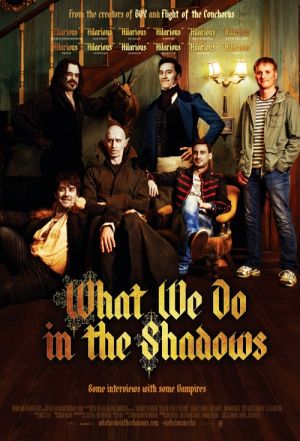
By Duncan Sinclair
Many people believe that vampire legends have been bled dry (hee-hee) for use in popular culture. Most stories of the infamous bloodsuckers are told from the perspective of an everyman, who is intrigued and/or haunted by the existence of these creatures. This can lead to repeating the same tired tropes and stereotypes. The mockumentary What We Do In the Shadows, a comedic counterpoint to last year’s Only Lovers Left Alive, attempts to refigure the myth for modern society by creating undead characters that are relatable to contemporary audiences and giving them the spotlight. The result is a hilarious look at how flying, blood sucking, night-walking ghouls would go about their everyday activities.
The film follows three vampires (played by Jonathan Brugh and co-directors Taika Waititi and Jemaine Clement) who live together in a New Zealand flat. With no responsibilities beyond seeking blood they spend their time making outfits, pondering lost relationships, going to parties, and engaging in tomfoolery that is not as clever as they think it is. Their arrangement recalls a frat house in ways. An ancient vampire who “inducted” two of the main residents lives in the basement. They have human assistants who agree to do their grunt work in hopes of being “inducted” themselves. (A female helper laments that if she “had a dick” she’d have been bitten already.) And when tensions run high they resort to ritualistic shaming or other masculine forms of conflict resolution. (“Bat fight!”) By portraying centuries-old men as immature members of an “in group” Clement and Waititi suggest that our ideas of male camaraderie are as old as mythology itself.
It is a slight disappointment that the film never explains the full purpose of the film-within-the-film. The faux-documentary style is used to an enjoyable effect, but it feels as though it was done in response to the fad of mockumentary TV shows (such as Clement’s Flight of the Conchords) as a way to tell a story while having an excuse to give us info-dumps. It becomes noticeably staged after a while, though at a brisk 85 minutes, it never begins to feel stale.
There are obvious hardships to being immortal demons, and the film is aware enough of that to make the characters sympathetic. If there is an underlying message to the film, it is that those with similar problems can find comfort in one another. Throughout the film the vampires cross paths with a pack of werewolves who operate as a support group. They initially lock horns, but grow to see them as equally troubled by their own existence and begin efforts at reconciliation. The film ends satisfyingly by showing each character having learned a little about how to overcome your worries and get along in life. Which is important when your life (or in this case, death) is everlasting.